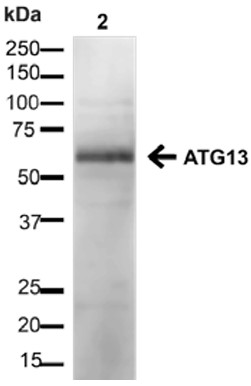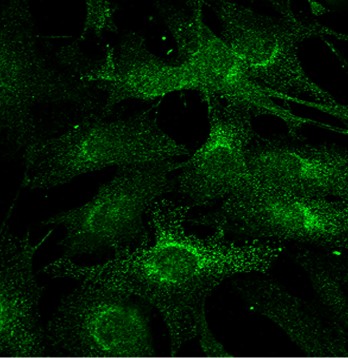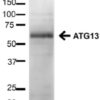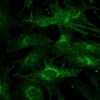Anti-Atg13 Antibody (23008)
$466.00
SKU: 23008
Categories: Antibody Products, Autophagy Antibodies, Products
Overview
Product Name Anti-Atg13 Antibody (23008)
Description Anti-Atg13 Rabbit Polyclonal Antibody
Target Atg13
Species Reactivity Human
Applications WB,ICC/IF
Host Rabbit
Clonality Polyclonal
Immunogen Synthetic peptide corresponding to mid-protein amino acids of human Atg13.
Properties
Form Liquid
Concentration 1.0 mg/mL
Formulation PBS, pH 7.4, 50% glycerol, 0.09% sodium azide.Concentration: 1mg/ml
Buffer Formulation Phosphate Buffered Saline
Buffer pH pH 7.4
Buffer Anti-Microbial 0.09% Sodium Azide
Buffer Cryopreservative 50% Glycerol
Format Purified
Purification Purified by Protein A affinity chromatography
Specificity Information
Specificity This antibody recognizes human Atg13.
Target Name Autophagy-related protein 13
Target ID Atg13
Uniprot ID O75143
Gene Name ATG13
Sequence Location Cytoplasm, cytosol, Preautophagosomal structure
Biological Function Autophagy factor required for autophagosome formation and mitophagy. Target of the TOR kinase signaling pathway that regulates autophagy through the control of the phosphorylation status of ATG13 and ULK1, and the regulation of the ATG13-ULK1-RB1CC1 complex. Through its regulation of ULK1 activity, plays a role in the regulation of the kinase activity of mTORC1 and cell proliferation. {PubMed:18936157, PubMed:19211835, PubMed:19225151, PubMed:19287211, PubMed:21795849, PubMed:21855797}.
Research Areas Autophagy
Background Autophagy is a catabolic process that results in the degradation of bulk cytoplasmic contents within autophagosomes and lysosomes. Atg13 is a target of the TOR kinase signaling pathway that regulates autophagy through the control of the phosphorylation status of Atg13 and ULK1, and the regulation of the Atg13-ULK1-RB1CC1 complex. Under starvation conditions, Atg13 is localized to puncate structures primarily representing the isolation membrane; the isolation membrane sequesters a portion of the cytoplasm resulting in autophagosome formation. Phosphorylation of Atg13 depends on nutrient conditions; it is dephosphorylated during starvation or following treatment with rapamycin. Three isoforms of the human protein are produced by alternative splicing.
Application Images



Description Immunoblotting: use at 1-2ug/ml. A band of ~56-63kDa is detected. Detection of Atg13 in HEK 293 cell lysate.

Description Immunofluorescence: use at 10ug/ml. Detection of Atg13 in formaldehyde-fixed C2C12 cells.
Handling
Storage This antibody is stable for at least one (1) year at -20°C.
Dilution Instructions Dilute in PBS or medium that is identical to that used in the assay system.
Application Instructions Immunoblotting: use at 1-2ug/mL. A band of ~56-63kDa is detected.
Immunofluorescence: use at 10ug/mL.
These are recommended concentrations.
Endusers should determine optimal concentrations for their applications.
Immunofluorescence: use at 10ug/mL.
These are recommended concentrations.
Endusers should determine optimal concentrations for their applications.
References & Data Sheet
Data Sheet  Download PDF Data Sheet
Download PDF Data Sheet
 Download PDF Data Sheet
Download PDF Data Sheet





